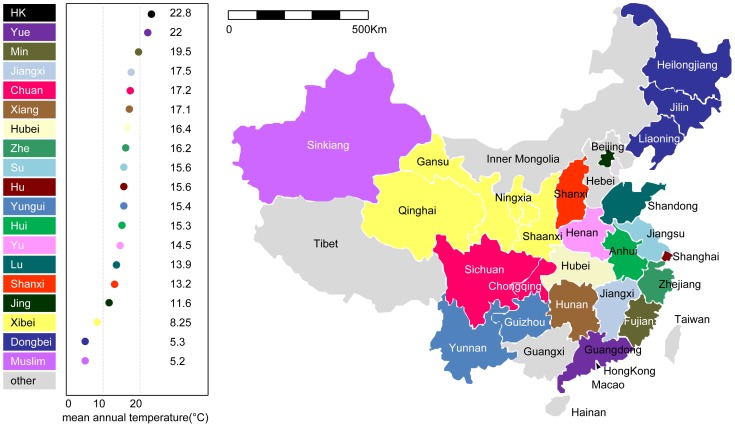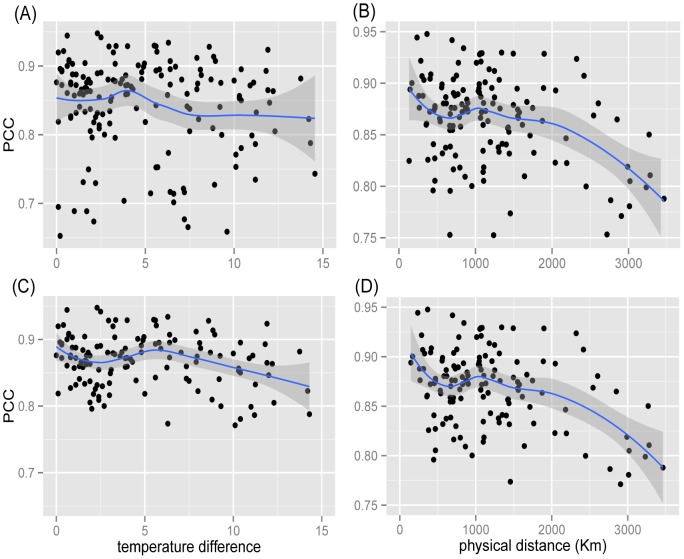Abstract
Food occupies a central position in every culture and it is therefore of great interest to understand the evolution of food culture. The advent of the World Wide Web and online recipe repositories have begun to provide unprecedented opportunities for data-driven, quantitative study of food culture. Here we harness an online database documenting recipes from various Chinese regional cuisines and investigate the similarity of regional cuisines in terms of geography and climate. We find that geographical proximity, rather than climate proximity, is a crucial factor that determines the similarity of regional cuisines. We develop a model of regional cuisine evolution that provides helpful clues for understanding the evolution of cuisines and cultures.
Introduction
The most essential need for all living organisms is energy, which is usually obtained by consuming food. So it is not hard to imagine why food affects all aspects of human life and culture [1]–[3]. Food has been studied in depth by many disciplines including history [4]–[7], sociology [8]–[10], philosophy [11], [12], literary criticism [13], etc. Understanding how food culture evolves will have profound impact on numerous domains. Despite its manifest importance, few studies have taken quantitative, systematic approaches towards food culture, mainly due to the scarcity of systematically collected databases.
Nevertheless, such an approach is promising. For example, one pioneering study revealed the connections between climate and the use of spices through the manual digitization of a large number of traditional recipes [14]. Recent increases in online recipe repositories have begun to allow for easier access to structured recipe data [15]–[17]. Harnessing this opportunity, we address the following questions about the evolution of regional cuisines: (1) How does the similarity between regional cuisines scale with geographical distance? (2) Is climate similarity the main factor determining similarity? Climate obviously plays an important role in shaping food culture, because it both limits the availability of ingredients and affects the usage of spices [14]. However, geographical proximity alone might drive nearby cuisines close because of frequent communication and migration. To address these questions, we examine regional recipes in China – the second largest and the most populous country in the world, which is home to over 1.3 billions of people with diverse cultural heritages. The landmass of China spans North-South and East-West rather evenly, providing a good test bed to study the effect of geography and climate.
Our investigation suggests that geographical distance alone plays a more important role than climate. Based on our results, we propose a model of cuisine evolution based on the copy-mutate mechanism. The key idea is that nearby regional cuisines tend to learn from each other either due to communication or migration. We demonstrate that our simple model reproduces important characteristics of the real data.
Data and Methods
Data collection
In April 2012 we downloaded all the recipes from the Chinese recipe website Meishijie (http://www.meishij.net/), which categorizes all recipes into  regional cuisines. Figure 1 shows a map of China and the mean annual temperature of each region, annotated with the names of provinces and cuisines, where the colors represent cuisines. Multiple provinces may belong to the same cuisine. Each recipe has the following properties: (i) a cuisine (each recipe belongs to only one cuisine); (ii) a list of ingredients; and (iii) a cooking method. We manually consolidated synonymous ingredient names and removed the recipes that do not have a cooking method or have too few (less than three) ingredients. There are 8,498 recipes and 2,911 ingredients in the cleaned dataset. Basic statistics of the dataset are reported in Table 1. Figure 2 shows that the number of ingredients per recipe is similarly distributed across all regions (the mode is around 10).
regional cuisines. Figure 1 shows a map of China and the mean annual temperature of each region, annotated with the names of provinces and cuisines, where the colors represent cuisines. Multiple provinces may belong to the same cuisine. Each recipe has the following properties: (i) a cuisine (each recipe belongs to only one cuisine); (ii) a list of ingredients; and (iii) a cooking method. We manually consolidated synonymous ingredient names and removed the recipes that do not have a cooking method or have too few (less than three) ingredients. There are 8,498 recipes and 2,911 ingredients in the cleaned dataset. Basic statistics of the dataset are reported in Table 1. Figure 2 shows that the number of ingredients per recipe is similarly distributed across all regions (the mode is around 10).
Figure 1. Map of regional cuisines in China.
Table 1. The basic statistics of regional cuisines in China.
| Regional Cuisine |

|

|

|

|
Location |
| Lu | 1,066 | 788 | 64 | 10.8452 | Shandong |
| Chuan | 1,148 | 877 | 195 | 10.4608 | Sichuan, Chongqing |
| Yue | 775 | 900 | 23 | 10.2839 | Guangdong |
| Su | 372 | 573 | 88 | 10.3199 | Jiangsu |
| Min | 468 | 648 | 69 | 10.1880 | Fujian |
| Zhe | 460 | 594 | 14 | 10.5978 | Zhejiang |
| Xiang | 691 | 592 | 7 | 11.4660 | Hunan |
| Hui | 218 | 442 | 111 | 9.8899 | Anhui |
| Dongbei | 358 | 458 | 237 | 10.0363 | Jilin, Heilongjiang, Liaoning |
| HK | 151 | 367 | 210 | 9.4040 | Hong Kong |
| Hubei | 160 | 266 | 115 | 10.7375 | Hubei |
| Hu | 744 | 692 | 117 | 9.4274 | Shanghai |
| Jiangxi | 143 | 210 | 87 | 10.3147 | Jiangxi |
| Jing | 606 | 565 | 74 | 10.3614 | Beijing |
| Other | 52 | 171 | 16 | 9.5962 | - |
| Muslim | 521 | 426 | 131 | 10.7524 | Sinkiang |
| Shanxi | 125 | 191 | 5 | 11.4720 | Shanxi |
| Xibei | 188 | 338 | 52 | 10.8351 | Shaanxi, Gansu, Qinghai, Ningxia |
| Yu | 173 | 291 | 10 | 10.6936 | Henan |
| Yungui | 79 | 184 | 23 | 8.8101 | Guizhou, Yunnan |
| All | 8,498 | 2911 | - | 10.4399 | - |
There are  different regional cuisines in total. The eight major regional cuisines, labeled in bold, are the most representative and typical cuisines in China.
different regional cuisines in total. The eight major regional cuisines, labeled in bold, are the most representative and typical cuisines in China.  : number of recipes.
: number of recipes.  : number of ingredients.
: number of ingredients.  : number of ingredients used only in the cuisine.
: number of ingredients used only in the cuisine.  : average number of ingredients in a recipe. The last column reports the provinces where a regional cuisine originates in.
: average number of ingredients in a recipe. The last column reports the provinces where a regional cuisine originates in.
Figure 2. Probability distribution of the number of ingredients per recipe.
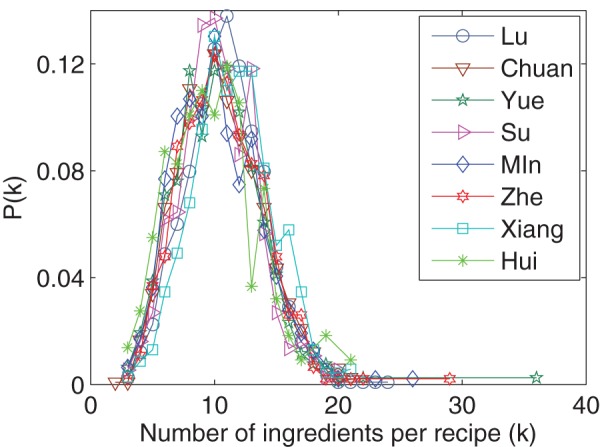
All regional cuisines show similar distributions, which have a peak around  .
.
As previously observed, the ingredient usage frequency follows a skewed distribution; only a small fraction of popular ingredients are widely used, while many ingredients are observed in only a small number of recipes. As shown in Fig. 3, the frequency distribution of ingredients follows a power-law [18] ( using method in paper [19]), capturing the intuition that a few ingredients such as salt, sugar, and egg constitute a major part of our every-day diet. As a result, the set of distinct ingredients roughly follows Heap's law, as seen in Fig. 4, with an exponent around
using method in paper [19]), capturing the intuition that a few ingredients such as salt, sugar, and egg constitute a major part of our every-day diet. As a result, the set of distinct ingredients roughly follows Heap's law, as seen in Fig. 4, with an exponent around  . According to the method in previous work [20], the exponent of Zipf's law corresponding to Fig. 3 can be estimated by
. According to the method in previous work [20], the exponent of Zipf's law corresponding to Fig. 3 can be estimated by  . The product of this exponent and the exponent of Heap's law (0.64) is close to 1, which is consistent with the previous result [21].
. The product of this exponent and the exponent of Heap's law (0.64) is close to 1, which is consistent with the previous result [21].
Figure 3. Cumulative frequency distribution of ingredient usage.
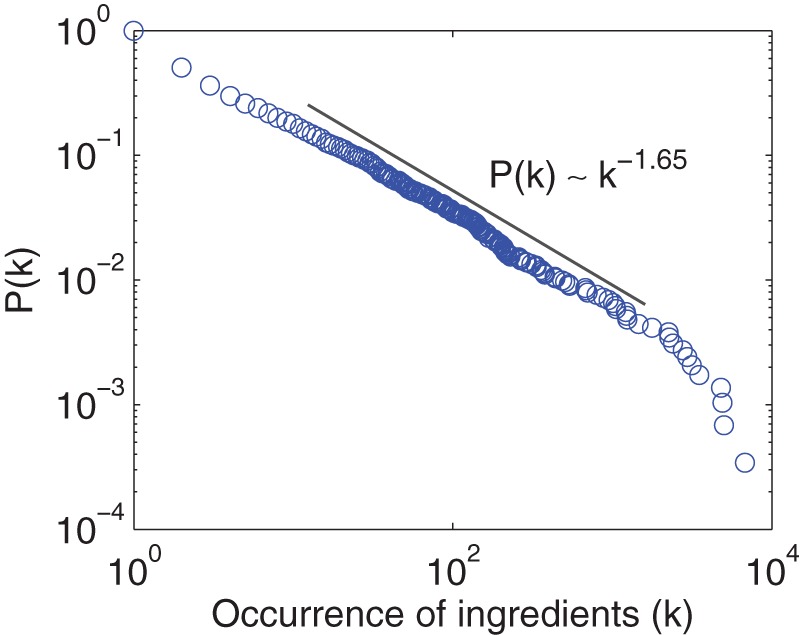
The usage frequency is calculated using all recipes in our dataset. The exponent is obtained by the method in previous work [19].
Figure 4. The number of distinct ingredients discovered vs. the number of recipes scanned.
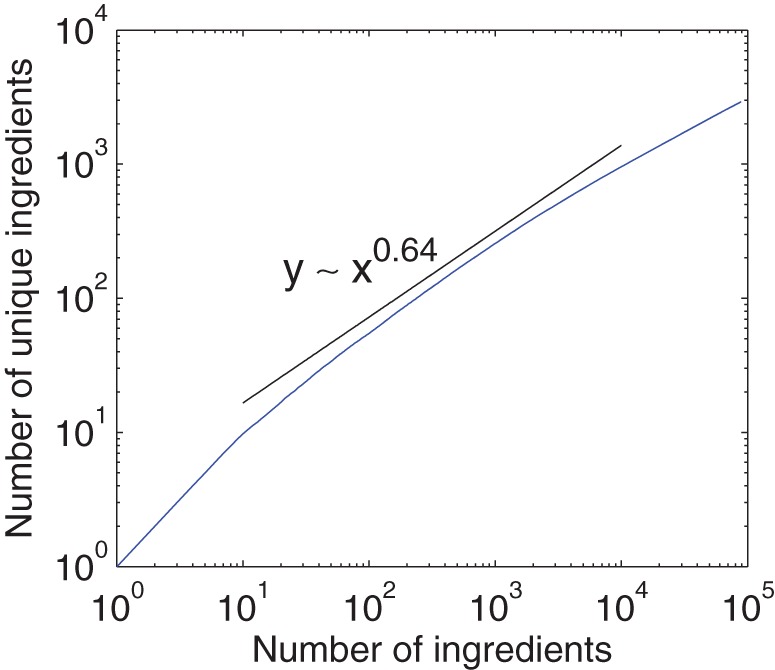
The plot (blue curve) approximately follows Heap's law (black guideline). The graph is obtained by averaging  implementations with independently random sequences of recipes.
implementations with independently random sequences of recipes.
Quantifying similarity between cuisines
Our dataset can be considered as a bipartite network with a set of recipes and a set of ingredients. An edge between a recipe and an ingredient indicates that the recipe contains the corresponding ingredient. Since each recipe belongs to one and only one regional cuisine, the edges could be categorized into cuisines. Given a cuisine  and an ingredient
and an ingredient  , we use
, we use  to denote the degree of ingredient
to denote the degree of ingredient  , counted with edges in cuisine
, counted with edges in cuisine  . In other words,
. In other words,  is the number of recipes (in cuisine
is the number of recipes (in cuisine  ) that use ingredient
) that use ingredient  . Therefore, the ingredient-usage vector of regional cuisine
. Therefore, the ingredient-usage vector of regional cuisine  is written in the following form:
is written in the following form:
| (1) |
where  is the probability of ingredient
is the probability of ingredient  appears in cuisine
appears in cuisine  . For example, if recipes in a regional cuisine
. For example, if recipes in a regional cuisine  use
use  ingredients (with duplicates) in total and ingredient
ingredients (with duplicates) in total and ingredient  appears in
appears in  recipes in that cuisine, we have
recipes in that cuisine, we have  .
.
Since common ingredients carry little information, we use an ingredient-usage vector inspired by TF-IDF (Term Frequency Inverse Document Frequency) [22]:
| (2) |
where a prior weight  is introduced to penalize a popular ingredient. We use
is introduced to penalize a popular ingredient. We use  for all calculations in this paper. With this representation in hand, we quantify the similarity between two cuisines using the Pearson correlation coefficient (Eq. 3) and cosine similarity (Eq. 4).
for all calculations in this paper. With this representation in hand, we quantify the similarity between two cuisines using the Pearson correlation coefficient (Eq. 3) and cosine similarity (Eq. 4).
- Pearson product-moment correlation [23]: This metric measures the extent to which a linear relationship is present between the two vectors. It is defined as
where
(3)  and
and  are ingredient-usage vectors of regional cuisine
are ingredient-usage vectors of regional cuisine  and
and  , respectively.
, respectively. - Cosine similarity [24]: It is a measure of similarity between two vectors of an inner product space that measures the cosine of the angle between them. For regional cuisines
 and
and  , the cosine similarity is represented using a dot product and magnitude as
, the cosine similarity is represented using a dot product and magnitude as
(4)
Results
Outlier detection
As an overview, we apply Principal Component Analysis to identify principal components of the ingredient usage matrix [25]. The distributions of regional cuisines in two principal components (capturing 44% of the information) are presented in Fig. 5. The two most obvious outliers (in solid red) are Yungui and Hong Kong cuisine. This may reflect the facts that ethnic minorities have historically resided in the Yungui region and that Hong Kong was ruled by the British Empire and Japan for more than 100 years.
Figure 5. The distribution of regional cuisines in the first two principal component spaces.
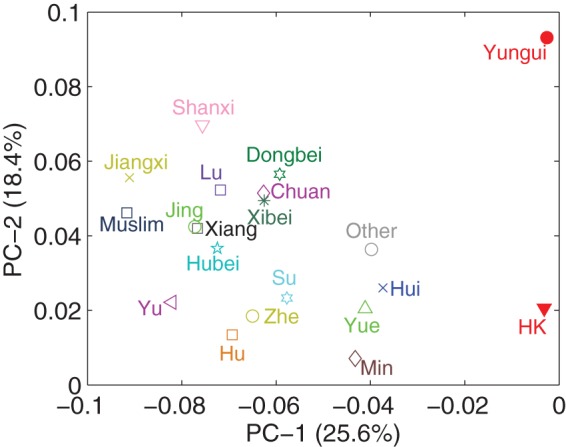
YunGui and Hong Kong (red) stand out as outliers.
Geography and climate
Climate shapes ingredient-usage patterns not only by affecting the availability of ingredients but also by exerting other pressures, such as a need to use additional spices as preservatives [14]. At the same time, we expect nearby regions to have a higher probability of similar food culture even without similar climate, because they are more likely to have more communication and migration.
To estimate the effect of climate we use temperature as a proxy. We assume that the annual average temperature approximately captures one of the most fundamental aspects of climates. As shown in the previous work on spices [14], annual temperature strongly predicts the usage of spices, and we further assume that temperature is a strong climate factor that affects ingredient availability. For two regions  and
and  , the temperature difference
, the temperature difference  is simply
is simply  , where
, where  is the annual average temperature of region
is the annual average temperature of region  .
.
We quantify geographical proximity using two distance measures: physical distance and topological distance. We measure physical distance between two cuisines by identifying the central cities of the cuisines and then calculating the great-circle distance [26]. To measure topological distance between two cuisines, we construct a graph of cuisines, where a node represents a regional cuisine and an edge represents the adjacency of two cuisines, we then measure topological distance by the shortest path length on the graph. Figure 6 shows that the geographical distance and topological distance are correlated yet exhibit large variance.
Figure 6. Topological distance vs. physical distance.
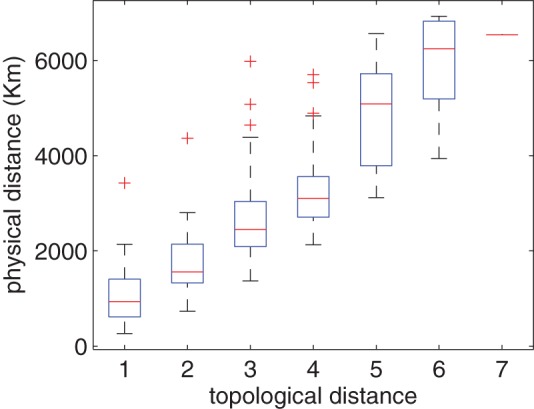
Figure 7 shows the relationship between the number of spices per meat-based recipe in a region and the mean annual temperature of the region. The correlation is insignificant ( -value is 0.238), in contrast to the results of the previous work [14]. Our result may arise due to the fact that China is still a single country with smaller temperature variation than the whole world.
-value is 0.238), in contrast to the results of the previous work [14]. Our result may arise due to the fact that China is still a single country with smaller temperature variation than the whole world.
Figure 7. Number of spices per recipe vs. mean annual temperature.
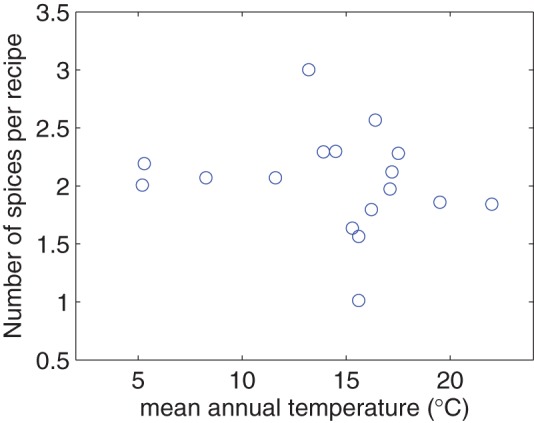
Figure 8 compares how temperature and physical distance are related to the similarities between regional cuisines. The left column shows the results of temperature and the right column shows that of physical distance. Each circle represents a pair of cuisines. The Pearson correlation coefficient between the temperature difference and PCC is −0.134 (Figure 8A), indicating a weak correlation between similarity of regional cuisines and their temperature difference. When we delete the two outliers mentioned above (Yungui and HK), the Pearson correlation coefficient between the temperature difference and PCC becomes −0.216 (Figure 8C). That is, regions with similar temperature tend to share similar usage patterns of ingredients, which is consistent with previous results [14]. However, this may not be the effect of temperature, because climate is correlated with distance. The Pearson correlation coefficient between the physical distance and PCC is −0.289 (Figure 8B), indicating a stronger correlation. When neglecting outliers, it becomes −0.385 (Figure 8D). The  -values of all cases indicate significant difference (
-values of all cases indicate significant difference ( for both cases).
for both cases).
Figure 8. The dependence of similarities between different regional cuisines on the climate and geography.
(A): scatter plot of PCC and temperature difference (all regional cuisine pairs); (B): scatter plot of PCC and physical distance (all regional cuisine pairs); (C): scatter plot of PCC and temperature difference (neglecting outliers); (D): scatter plot of PCC and temperature difference (neglecting outliers).
The previous analysis does not provide a complete picture, since geography and climate are strongly correlated; nearby regions are more likely to have similar climates. To estimate the effect of climate and geographical proximity, we calculate partial correlation [27], which is used to measure the linear association between two factors while removing the effect of other additional factors. The partial correlation coefficients between physical distance and PCC, given temperature difference as a control variable, is −0.280. However, the partial correlation between temperature difference and ingredient usage similarity, given physical distance as a control variable, the expected negative correlation completely vanishes and the correlation coefficient becomes 0.116. Our results indicate that the effect of temperature on the ingredient usage pattern may not exist at all. The results with cosine and the cases without outliers also show the same tendency.
Here we examine the relationship between topological distance and the similarity of cuisines. Figure 9 shows the similarity distribution of cuisines with respect to topological distance. Analysis of variance (ANOVA) [28] shows that the difference in the similarity distribution is significant ( for both cases). The figure shows a clear trend that geographically closer regional cuisines have more similar ingredient usage patterns. We perform a simple permutation significance test by classifying all regional cuisine pairs into two classes: the first class contains regional cuisine pairs with topological distance less than or equal to 2, and the second class contains those of topological distance larger than 2. Denote the similarities of two classes as
for both cases). The figure shows a clear trend that geographically closer regional cuisines have more similar ingredient usage patterns. We perform a simple permutation significance test by classifying all regional cuisine pairs into two classes: the first class contains regional cuisine pairs with topological distance less than or equal to 2, and the second class contains those of topological distance larger than 2. Denote the similarities of two classes as  (far, with topological distance
(far, with topological distance  ) and
) and  (close, with topological distance
(close, with topological distance  ), and
), and  and
and  is the mean of
is the mean of  and
and  , respectively.
, respectively.  and
and  are the sample sizes corresponding to each group. The null hypothesis
are the sample sizes corresponding to each group. The null hypothesis  says the two classes
says the two classes  and
and  have identical probability distributions. We performed the test as follows. First, the difference between
have identical probability distributions. We performed the test as follows. First, the difference between  and
and  is calculated. This is the observed value of the test statistic, namely
is calculated. This is the observed value of the test statistic, namely  . The observations of classes
. The observations of classes  and
and  are then pooled. Next, the difference in sample means is calculated and recorded for every possible way of dividing these pooled values into two groups of size
are then pooled. Next, the difference in sample means is calculated and recorded for every possible way of dividing these pooled values into two groups of size  and
and  , denoted by
, denoted by  . Lastly, the one-sided
. Lastly, the one-sided  -value of the test is calculated as
-value of the test is calculated as  . The
. The  -values of Fig. 9 indicate significant difference (
-values of Fig. 9 indicate significant difference ( for both cases).
for both cases).
Figure 9. Similarity distributions of regional cuisine pairs with different topological distance ( ,
,  ,
,  ,
,  ).
).
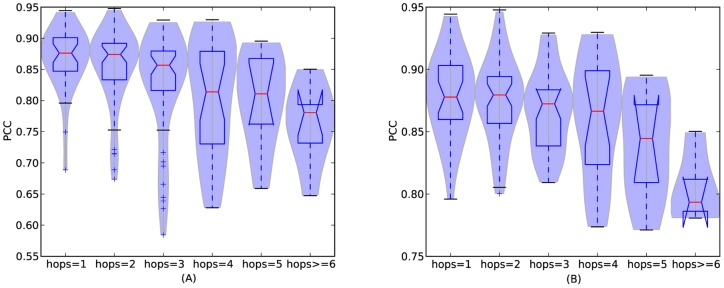
(A): result for all regional cuisines; (B): result when neglecting outliers.
Model and Validation
We build an evolution model of Chinese cuisines based on the simple notion that geographical proximity breeds more communication and migration. Our model uses the copy-and-mutate model of recipe evolution [16]. We tested two models that use topological distance and physical distance, respectively, and found that the model using topological distance produces better results. There are three elements in the model: regional cuisines, recipes, and ingredients. We assume the same set of Chinese regional cuisines in the same location. A recipe is a set of ingredients and belongs to one of the regional cuisines. We assume that each recipe has exactly the same number of ingredients ( ). Each ingredient
). Each ingredient  has a fitness value
has a fitness value  , randomly drawn from a uniform distribution in
, randomly drawn from a uniform distribution in  . This fitness represents intrinsic properties such as nutritional value, flavor, cost, and availability [16]. All the symbols used in our model are listed in Table 2.
. This fitness represents intrinsic properties such as nutritional value, flavor, cost, and availability [16]. All the symbols used in our model are listed in Table 2.
Table 2. Notations for parameters and quantities in the model.

|
number of all ingredients |

|
 number of initial ingredients at time number of initial ingredients at time |

|
number of all recipes |

|
 number of recipes in the regional cuisine number of recipes in the regional cuisine |

|
 number of initial recipes in the regional cuisine number of initial recipes in the regional cuisine  at time at time |

|
number of ingredients per recipe |

|
 number of ingredients to be mutated in each recipe, number of ingredients to be mutated in each recipe, |

|
probability of interaction |

|
 the fitness of ingredient the fitness of ingredient |

|
 the topological distance of regional cuisine the topological distance of regional cuisine  and and |
Let us describe our model in detail. In the initial state there are  ingredients in the ingredient pool, and each regional cuisine contains one recipe that consists of
ingredients in the ingredient pool, and each regional cuisine contains one recipe that consists of  random ingredients chosen from the initial ingredient set; that is,
random ingredients chosen from the initial ingredient set; that is,  .
.
Step 1
Choose one regional cuisine preferentially. Regional cuisine  is chosen with probability
is chosen with probability
| (5) |
where  is the number of recipes of regional cuisine
is the number of recipes of regional cuisine  and
and  is the total number of recipes of all regional cuisines. With probability
is the total number of recipes of all regional cuisines. With probability  the chosen regional cuisine (
the chosen regional cuisine ( ) will interact with another region (Step 2). With probability
) will interact with another region (Step 2). With probability  cuisine
cuisine  will develop a recipe itself by randomly selecting
will develop a recipe itself by randomly selecting  unique ingredients from the ingredient pool.
unique ingredients from the ingredient pool.
Step 2
Generate a recipe by learning from others. With probability proportional to their topological distance, cuisine  will select another regional cuisine
will select another regional cuisine  . Regional cuisine
. Regional cuisine  will be chosen with probability
will be chosen with probability
| (6) |
where  is the topological distance between cuisine
is the topological distance between cuisine  and
and  .
.  is a free parameter to tune the importance of topological distance. Regional cuisines with smaller topological distance from cuisine
is a free parameter to tune the importance of topological distance. Regional cuisines with smaller topological distance from cuisine  will have higher probability to be chosen in this step when
will have higher probability to be chosen in this step when  . Assuming cuisine
. Assuming cuisine  is chosen to interact with
is chosen to interact with  , then cuisine
, then cuisine  will randomly choose one recipe of cuisine
will randomly choose one recipe of cuisine  as a template and copy it. From this copy, we randomly chose an ingredient
as a template and copy it. From this copy, we randomly chose an ingredient  and compare it with an ingredient
and compare it with an ingredient  that is randomly chosen from the ingredients pool, if
that is randomly chosen from the ingredients pool, if  , we replace ingredient
, we replace ingredient  by ingredient
by ingredient  . This process is repeated
. This process is repeated  times. We then execute Step 3.
times. We then execute Step 3.
Step 3
Add new ingredients. With probability  we add one new ingredient to the ingredients pool and replace the ingredient having the smallest fitness in the recipe that was generated in the previous steps with the new ingredient in order to assure all the ingredients in the ingredient pool have been used. We then add the modified new recipe to the pool of cuisine
we add one new ingredient to the ingredients pool and replace the ingredient having the smallest fitness in the recipe that was generated in the previous steps with the new ingredient in order to assure all the ingredients in the ingredient pool have been used. We then add the modified new recipe to the pool of cuisine  . If no new ingredient is added in this step, we then add the new recipe to the pool of cuisine
. If no new ingredient is added in this step, we then add the new recipe to the pool of cuisine  without modification. If we already have
without modification. If we already have  recipes, stop the simulation, or else repeat the previous steps.
recipes, stop the simulation, or else repeat the previous steps.
The parameters  and
and  are obtained from the data. For simplicity, we set
are obtained from the data. For simplicity, we set  , which means that every recipe has ten unique ingredients. In the initial state, there are
, which means that every recipe has ten unique ingredients. In the initial state, there are  ingredients in the ingredient pool, and each regional cuisine contains one recipe chosen randomly from the initial ingredients; that is,
ingredients in the ingredient pool, and each regional cuisine contains one recipe chosen randomly from the initial ingredients; that is,  . The cuisines then evolve as new recipes and ingredients join over time. We used
. The cuisines then evolve as new recipes and ingredients join over time. We used  ,
,  , and
, and  , which generates results that closely resemble the empirical findings. Figure 10 demonstrates that our model produces a qualitatively similar, skewed degree distribution.
, which generates results that closely resemble the empirical findings. Figure 10 demonstrates that our model produces a qualitatively similar, skewed degree distribution.
Figure 10. Cumulative frequency distribution of the cuisine network generated by our model compared to the the empirical distribution from the dataset of Chinese cuisine.
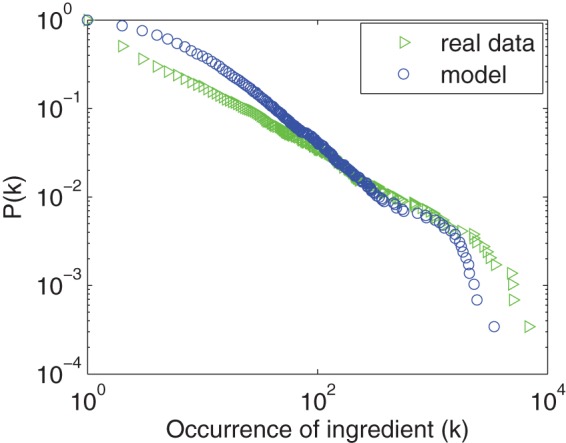
Figure 11 shows the comparison between the real data and our model in terms of the similarity distribution with topological distance. Fig. 11A is the result of all regional cuisine pairs, displaying that our model can achieve the similar tendency as the real dataset, although the real dataset shows more diversity than our model. We think this is a result of the existence of outliers in the dataset. Fig. 11B shows the result without outliers, displaying a better match with our dataset. The liner correlation between the results of the model and the dataset are both larger than  , indicating a strong correlation. Figure 12 shows the dependency between physical distance and cuisine similarity in our model. The results display a similar tendency found in the real data (B and D in Fig. 8). Results of cosine similarity are not displayed, as all of them display similar tendencies with PCC.
, indicating a strong correlation. Figure 12 shows the dependency between physical distance and cuisine similarity in our model. The results display a similar tendency found in the real data (B and D in Fig. 8). Results of cosine similarity are not displayed, as all of them display similar tendencies with PCC.
Figure 11. Similarity distributions of regional cuisine pairs with different topological distance ( ,
,  and
and  ).
).
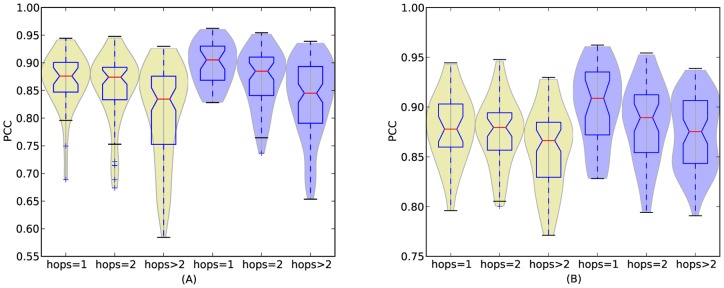
The blue ones are the results generated by our model, while the yellow ones are results of the dataset. (A): result for all regional cuisines; (B): result when neglecting outliers.
Figure 12. The dependence of similarities between different regional cuisines on the geographical distance in the model.
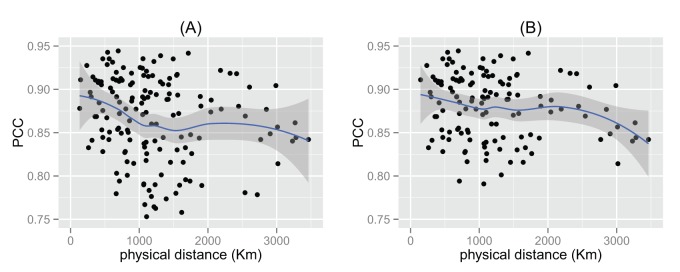
(A): result for all regional cuisines; (B): result when neglecting outliers.
Conclusion and Discussion
We empirically analyzed the similarity relations between major regional cuisines in China in terms of climate and physical proximity. We found that climate (temperature) does not show any correlation with ingredient usage similarity if we control geographical distance, while geographical proximity seems to be a key factor in the shaping of regional cuisines. Based on the finding, we proposed a copy-and-mutate model that incorporates geographical proximity. We showed that the results of our model agree with our empirical findings.
Acknowledgments
We thanks Huawei Shen, Yu Huang, Shaojian Wang and Giovanni Luca Ciampaglia for helpful discussion and useful suggestion, and John McCurley for editorial assistance.
Funding Statement
Funding came from National Natural Science Foundation of China under Grant Nos. 11105024, 11205042, 11105025, and 11305043 Program of Outstanding PhD Candidate in Academic Research by UESTC (Grant Nos. YBXSZC20131035, YBXSZC20131034) and China Scholarship Council. The funders had no role in study design, data collection and analysis, decision to publish, or preparation of the manuscript.
References
- 1.Counihan C, Esterik PV (1997) Food and culture: a reader. Routledge, London. [Google Scholar]
- 2.Richards AI (1939) Hunger and work in a savage tribe. Routledge, London. [Google Scholar]
- 3. Firth R (1934) The sociological study of native diet. Journal of the international institute of african languages and cultures VII: 401–414. [Google Scholar]
- 4.Moyers S (1996) Garlic in health, history, and world cuisine. Suncoast Press. [Google Scholar]
- 5.Tregear A (2003) From Stilton to Vimto: Using Food History to Re-think Typical Products in Rural Development. Wiley-Blackwell. [Google Scholar]
- 6.Civitello L (2011) Cuisine and Culture: A History of Food and People. Wiley; 3th edition. [Google Scholar]
- 7.Diamond JM (1999) Guns, Germs, and Steel: The Fates of Human Societies. W. W. Norton and Company. [Google Scholar]
- 8.Mennell SJ, Murcott A, Otterloo AHv (1993) The Sociology of Food: Eating, Diet and Culture. Sage Publications; 2nd edition. [Google Scholar]
- 9.Beardsworth A, Keil T (1997) Sociology on the Menu: An Invitation to the Study of Food and Society. Routledge. [Google Scholar]
- 10.Germov J, Williams L (2004) A Sociology of Food and Nutrition: The Social Appetite. Oxford University Press. [Google Scholar]
- 11.Allhoff F, Monroe D (2007) Food and Philosophy: Eat, Think, and Be Merry. Wiley-Blackwell; 1st edition. [Google Scholar]
- 12.Curtin DW, Heldke LM (1992) Cooking, Eating, Thinking: Transformative Philosophies of Food. Indiana University Press; 1st Edition edition. [Google Scholar]
- 13.Skubal SM (2002) Word of Mouth: Food and Fiction After Freud. Routledge. [Google Scholar]
- 14. Sherman PW, Billing J (1999) Darwinian gastronomy: Why we use spices. Bioscience 49: 453–463. [Google Scholar]
- 15. Ahn YY, Ahnert SE, Bagrow JP, Barabási AL (2011) Flavor network and the principles of food pairing. Scientific Reports 1: srep00196. [DOI] [PMC free article] [PubMed] [Google Scholar]
- 16. Kinouchi O, Diez-Garcia RW, Holanda AJ, Zambianchi P, Roque AC (2008) The non-equilibrium nature of culinary evolution. New Journal of Physics 10: 073020. [Google Scholar]
- 17. Ahn YY, Ahnert SE (2013) The avor network. Leonardo 46: 272–273. [Google Scholar]
- 18. Barabási AL, Albert R (1999) Emergence of scaling in random networks. Science 286: 509–512. [DOI] [PubMed] [Google Scholar]
- 19. Clauset A, Shalizi CR, Newman M (2009) Power-law distributions in empirical data. SIAM Review 51: 661–703. [Google Scholar]
- 20.Adamic LA (2000) Zipf, power-law, and pareto – a ranking tutorial.
- 21. Lü L, Zhang ZK, Zhou T (2010) Zipf's law leads to heaps' law: Analyzing their relation in finite-size systems. PLoS ONE 5: e14139. [DOI] [PMC free article] [PubMed] [Google Scholar]
- 22.Salton G, McGill MJ (1986) Introduction to Modern Information Retrieval. McGraw-Hill Book Company, New York. [Google Scholar]
- 23. Rodgers JL, Nicewander AW (1988) Thirteen ways to look at the correlation coefficient. The American Statistician 42: 59–66. [Google Scholar]
- 24.Tan PN, Steinbach M, Kumar V (2005) Introduction to Data Mining. Addison-Wesley. [Google Scholar]
- 25.Jolliffe IT (2008) Principal Component Analysis. Springer, New York. [Google Scholar]
- 26. http://mathworld.wolfram.com/SphericalDistance.html.[Online; accessed 12-June-2013].
- 27.Cramér H (1999) Mathematical Methods of Statistics. Princeton University Press. [Google Scholar]
- 28.Freedman DA (2009) Statistical Models: Theory and Practice. Cambridge University Press. [Google Scholar]



